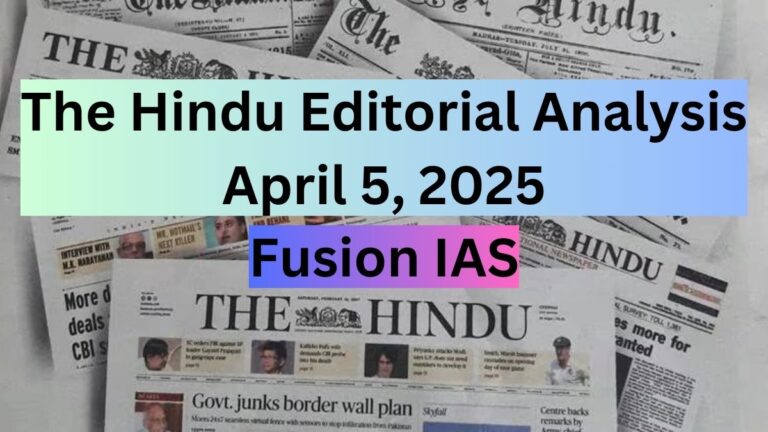
The Hindu editorials are a crucial resource for understanding key national and international issues. This analysis simplifies complex topics, highlights key points, and offers critical insights, making it an essential tool for competitive exam preparation like UPSC CSE and developing a well-rounded perspective on current affairs.
1. Gates in the sky: On ISRO and SpaDeX
Overview of SpaDeX and its Importance
- SpaDeX Mission: Launched on December 30, 2024, via the PSLV-C60 mission.
- Objective: Demonstrate orbital rendezvous and docking capabilities, a critical step for advanced space missions.
- Achievements:
- Docking of two satellites achieved on January 16, 2025, after overcoming challenges.
- Follow-up activities include electric power exchange, undocking, and testing payloads over two years.
2. Docking Technology: A Gateway to Advanced Space Missions
- Significance:
- Allows components to be launched separately and assembled in space, enabling larger and more complex missions.
- Key for interplanetary missions (e.g., Chandrayaan-4 lunar sample return).
- Supports long-duration missions, space-mining operations, and orbital resupply platforms.
- Future Applications:
- Crewed missions to Mars.
- Establishing orbital stations like the planned Bharatiya Antariksh Station (BAS).
3. Challenges Faced During SpaDeX
- Multiple attempts required to achieve docking due to unexpected satellite drift.
- Demonstrated ISRO’s adaptive approach:
- Postponements allowed recalibration.
- Continuous data collection and sufficient fuel ensured eventual success.
4. Complementary Advances in the PSLV-C60 Mission
- Fourth stage of the rocket used as an orbital platform, carrying 24 payloads.
- Highlights:
- Germination of cowpea seeds in orbit, showcasing potential for orbital agriculture.
5. Global Context of Docking Technology
- Strategic Importance: Docking is foundational for emerging areas like space mining, satellite servicing, and establishing permanent habitats in space.
- Comparative Analysis:
- ISRO is catching up with global leaders like NASA and Roscosmos.
- The ability to dock in space places ISRO among an elite group of space agencies.
6. Challenges for ISRO’s Future Plans
- Bharatiya Antariksh Station (BAS):
- ISRO must outline the utility and strategic vision of BAS to avoid resource misalignment.
- Cost Pressures:
- Longer missions demand cost-effective solutions.
- R&D in reusable technologies and efficient propulsion systems is crucial.
- Leadership Transition:
- With V. Narayanan as the new ISRO chairman, continuity in vision and execution becomes vital.
7. Key Takeaways and Way Forward
- SpaDeX’s success is a step toward greater self-reliance in space technologies.
- Docking capabilities position India for advanced interplanetary missions and contribute to global space collaboration.
- ISRO needs:
- A clear roadmap for its future goals, particularly BAS.
- Continued investment in R&D to remain globally competitive.
- Increased public engagement to enhance awareness and support for its missions.
8. Conclusion
ISRO’s success with SpaDeX is a testament to its evolving technological capabilities and ambition. However, as India sets its sights on becoming a leader in space exploration, defining a cohesive strategy for long-duration missions and advanced projects is imperative. This achievement reinforces India’s position in the global space race while paving the way for greater achievements in the future.
2. Great anniversaries of peace initiatives, a role for India
Historical Context of Peace Initiatives
- 80th Anniversary of the First Nuclear Weapon Test (1945):
- First detonation under the Manhattan Project, U.S., on July 16, 1945.
- Nuclear bombs dropped on Hiroshima and Nagasaki in August 1945, killing ~1,50,000 to 2,46,000 people.
- Prompted global concern over the destructive potential of nuclear weapons.
- 70th Anniversary of the Russell-Einstein Manifesto (1955):
- Called for averting nuclear disaster and emphasized: “Remember your humanity, and forget the rest.”
- Joseph Rotblat initiated a conference to assess the dangers posed by weapons of mass destruction.
- 70th Anniversary of the Avadi Resolution (1955):
- Indian National Congress plenary session in Avadi passed a resolution against atomic and hydrogen bombs.
- Advocated for the total prohibition of weapons of mass destruction and involvement of the UN Disarmament Commission.
2. Nuclear Threats in the Present Day
- Rising risks of nuclear confrontation due to:
- Russia’s revised nuclear doctrine declaring arms control obsolete.
- NATO’s missile deployment in Russian territory heightening tensions.
- Israel-Palestine conflict balancing precariously on nuclear threats.
- Non-state actors potentially accessing nuclear weapons via cyber and AI pathways.
- Current global nuclear arsenal (2024): ~12,100 warheads, significantly reduced from ~60,000 during the Cold War but still alarming.
3. India’s Legacy in Peace Advocacy
- Avadi Resolution (1955): Emphasized disarmament to save civilization from destruction.
- Rajiv Gandhi’s Action Plan (1988): Proposed a nuclear weapons-free and non-violent world order.
- Both initiatives highlighted India’s leadership in advocating peace and humanity.
4. The Need for Global Action
- Bertrand Russell’s warning: Humanity faces a choice between perishing or adopting common sense.
- Glimmers of hope in partial test bans and arms control agreements have not eliminated the risks.
5. India’s Role and Responsibility
- As a nuclear weapons state, India holds a moral and strategic responsibility to:
- Advocate for global disarmament.
- Lead efforts to prevent nuclear proliferation.
- Suggested Actions for India:
- Convene a global conference on preventing mass annihilation.
- Propose a new Action Plan to address the dangers of weapons of mass destruction.
- Revive the spirit of the Russell-Einstein Manifesto and the Avadi Resolution.
6. Conclusion
- 2025 marks significant anniversaries of global peace initiatives, emphasizing the urgency of nuclear disarmament and conflict resolution.
- India’s historical commitment to peace must translate into actionable leadership on the global stage, steering humanity away from annihilation toward sustainable peace.
Disclaimer:
This analysis is based on the editorial content published in The Hindu and is intended solely for informational and educational purposes. The views, opinions, and interpretations expressed herein are those of the author of original article. Readers are encouraged to refer to the original article for complete context and to exercise their own judgment while interpreting the analysis. The analysis does not constitute professional advice or endorsement of any political, economic, or social perspective.
Follow Fusion IAS


